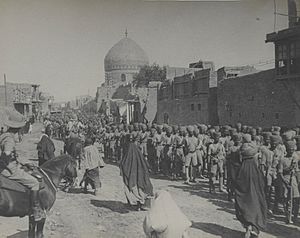Fall of Baghdad (1917) facts for kids
Quick facts for kids Fall of Baghdad |
|||||||
|---|---|---|---|---|---|---|---|
| Part of the Mesopotamian Campaign of World War I | |||||||
 General Maude's entry into Baghdad, 11 March 1917 |
|||||||
|
|||||||
| Belligerents | |||||||
| Commanders and leaders | |||||||
| Strength | |||||||
| I Corps III Corps (70,000 men) |
Sixth Army (25,000 men) | ||||||
| Casualties and losses | |||||||
| Unknown | 9,000+ captured | ||||||
The fall of Baghdad happened on 11 March 1917. It was a major event during the Mesopotamian Campaign in World War I. In this battle, forces from the British Empire fought against the Ottoman Empire. The British captured the important city of Baghdad.
General Maude Takes Command
After a tough loss at Kut in April 1916, the British Army in Mesopotamia needed a fresh start. A new leader, Lieutenant General Sir Frederick Stanley Maude, was put in charge. His main goal was to make the British Army strong again.
General Maude spent the rest of 1916 getting his army ready. Most of his soldiers came from India. They traveled by sea to Basra. While the troops trained, British engineers built a railway line. This railway helped move supplies from the coast inland. General Maude also got armed river boats and supply ships for his army.
The British started their new campaign on 13 December 1916. They had about 50,000 well-trained soldiers. Most were from British India and some were from the British Army. The Ottoman forces were smaller, with about 25,000 soldiers. They were led by General Khalil Pasha.
The Push Towards Baghdad
The British campaign went smoothly. General Maude moved carefully, advancing on both sides of the Tigris River. This careful approach earned him the nickname Systematic Joe. The Ottoman forces tried to stop them at a strong place called Khadairi Bend. The British captured it after two weeks of fighting.
Next, the British had to push the Ottomans out of a strong defense line along the Hai River. This took another two weeks. On 16 February, another Ottoman position, Dahra Bend, was taken. Finally, the British re-captured Kut on 24 February 1917. This was known as the Second Battle of Kut.
The Ottoman commander, Karabekir Bey, made sure his army did not get trapped in Kut. This was different from what happened to General Townshend in the First Battle of Kut.
The march towards Baghdad continued on 5 March 1917. Three days later, Maude's army reached the Diyala River. This river was just outside Baghdad.
Khalil Pasha decided to defend Baghdad at the meeting point of the Diyala and Tigris rivers. This was about 35 miles south of Baghdad. The Ottoman troops fought back against the first British attack on 9 March. General Maude then moved most of his army north. He planned to go around the Ottoman defenses and attack Baghdad directly. Khalil Pasha moved his army to match the British. He left only one group of soldiers to guard the Diyala River defenses.
The British quickly defeated this small group on 10 March 1917. This sudden loss made Khalil Pasha nervous. He ordered his army to retreat north towards Baghdad.
The Ottoman leaders ordered everyone to leave Baghdad at 8 p.m. on 10 March. But the situation was getting out of control for Khalil Pasha. The British followed closely behind the retreating Ottoman troops. They captured Baghdad without a fight on 11 March. A week later, General Maude gave a speech called the Proclamation of Baghdad. In it, he said, "Our armies do not come into your cities and lands as conquerors or enemies, but as liberators." About 9,000 Ottoman soldiers were captured by the British during the confusion.
What Happened Next
Capturing Baghdad was a big win for the British. It was another defeat for the Ottoman government. This victory helped the British feel better after their earlier loss at Kut. The Ottoman government had to stop its military actions in Persia. They also had to build a new army to stop the British from moving on to capture Mosul.
The British had already captured Basra Vilayet in 1914. Now they had taken the main city of Baghdad Vilayet. This was good news for the British forces. It meant they controlled more land in the region.


